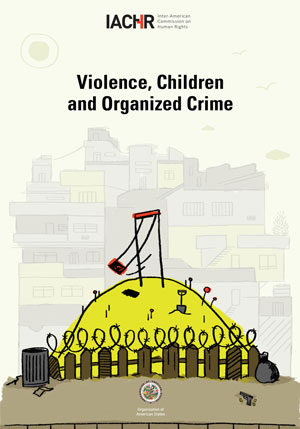Citizen Security from a
Children’s Rights Perspective
Recommendations to the States of the Americas
A Comprehensive Approach is Needed, One that Focuses on Children and Adolescents and the Protection and Restoration of their Rights
Security reforms being enacted in the Americas must make a paradigm shift in public safety.
This change should prioritize preventing and reducing violence, instead of prioritizing control and law enforcement functions.
Other matters that need improvement are the effective access to justice and to judicial guarantees, especially for certain groups. The barriers to access to justice should be eliminated; these include high costs, an overextended judicial system, tardiness in judicial proceedings, the poor quality of the investigation and charging processes, and the high level of impunity when it comes to prosecuting crimes.
Photo credit: Daniel Cima for IACHR
A Broad, Comprehensive, and Holistic Approach to Citizen Security
Achieving effective violence prevention requires taking a broad, comprehensive, and holistic approach that combines legal, social, educational, and economic strategies to reduce risk factors and strengthen protective factors.
Photo credit: IACHR
Social Policies and Access to Basic Services
Professionalization and Specialization
Information, Monitoring, and Evaluation Systems
Participation by Communities and by Children and Adolescents
Family Support and Strengthening
Decentralization and the Role of Local Governments
Municipalities are assigned responsibility for a significant number of aspects that have to do with violence prevention, even though responsibility for security (security forces) is usually handled at the national government level.
At the city level, violence and insecurity can be mitigated through social and urban planning policies that reduce exclusion, marginalization, and social fragmentation. It is necessary to expand public services in the communities most affected by poverty, invest in decent-housing programs, restore safe public spaces, and integrate disconnected parts of the city through investment in public infrastructure. These interventions improve the quality of life for people in these communities, promote the enjoyment of their rights, and help them become less marginalized and vulnerable.
It is a proven fact that the city model affects insecurity. One priority of local governments should be to promote safe, inclusive cities that contribute to a reduction in violence and crime.
Moreover, responsibilities associated with violence prevention include policies geared toward youth (such as sports, recreation, and culture), many of which have been decentralized to the local level.
Education: Staying in School
Education from a Human Right’s Perspective
Professional Training and Access to Decent Work
Recreation, Leisure, and Culture
Professionalization, Modernization, and Democratization of State Security Forces
A process to professionalize, modernize, and democratize State security forces must be implemented—a change of model under which the purpose of citizen security is seen as the protection of all persons, their rights, and the conditions in which they can exercise those rights.
These policies are characterized by:
Rethinking Isolated Assault and Combat Strategies
Community or Neighborhood Policing
Legitimate and Proportional Use of Force
Ongoing Training and Equipment
Documenting the Use of Force
Investigating Homicides by State Agents
Use of Non Lethal Force
Child-Specific Protocols
Photo credit: Daniel Cima for IACHR
How to address the problem of children and adolescents in violent gangs and maras?
To effectively address the problem, it must first be recognized that gangs and maras emerge from certain social contexts, situations of vulnerability in the exercise of rights, and a lack of appropriate policies for child protection, and that they end up filling a social vacuum.
The Need to Advance on Restorative Justice
Rehabilitation and Social Reintegration Programs
Adolescents should be offered the necessary support through socio-educational measures to ensure that they can positively and constructively reconnect with society, giving priority to the implementation of these measures at the level of community and family.
Increased Age of Criminal Responsibility
The age of criminal responsibility should be increased to 18 years old. Criminal offenders under 18 years of age should be placed under the purview of a specialized juvenile justice system, one that is restorative in nature, instead of the punitive and retributive model based on the deprivation of liberty.
Deprivation of Liberty of Adolescents: “A Last Resort”
Deprivation of liberty of adolescents should be used only as an exceptional measure of last resort, and for the least amount of time necessary.
Avoid Pretrial Detention of Adolescents
As a general rule, deprivation of liberty must be avoided prior to final judgment of a court when persons under 18 years of age are involved, unless the law provides for certain exceptions which would justify the limited use of pretrial detention, for a set period of time, with the maximum length of time established by law.
Photo Credit: CIDH

